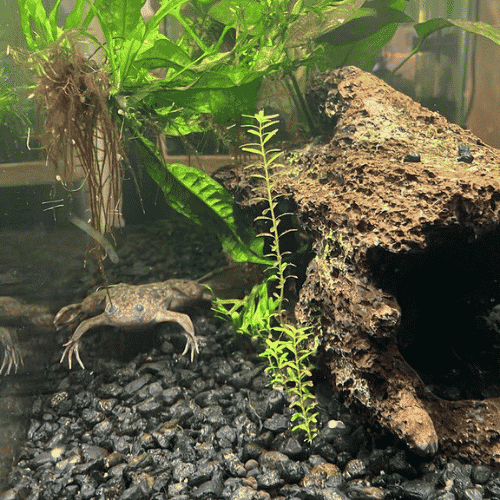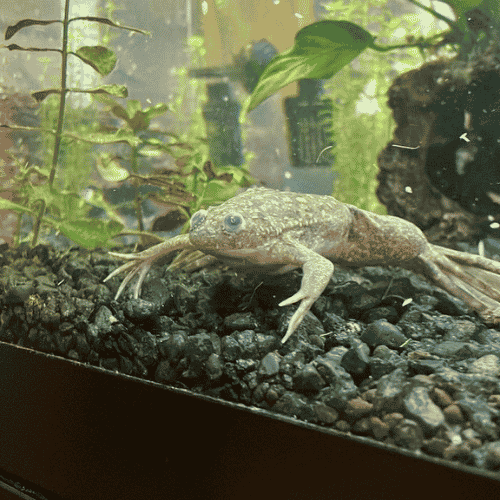Although native to the shallow streams, creeks, and ponds of Cameroon, Congo, and Nigeria, African Dwarf Frogs have migrated significantly, and can now be found in other warm countries with adequate river systems. They’ve since made the leap to exotic pet status, with an active presence in aquariums alongside other frogs and non-predatory fish.
Keeping these frogs as pets, however, requires a great deal of planning, and understanding of their personalities, and space requirements. African dwarf frogs have webbed feet, eyes on either side of their head, and a pointed snout. Females are often much larger than their male counterparts, reaching up to 3 inches in length.
While these frogs are often low maintenance, owners have to give sufficient consideration in choosing, and setting up the right habitat, especially when it comes to tank sizes. Space constraints can impact their quality of life, and similarly the habitat, and other tank mates must be chosen carefully, so as to bring the most out of them.
African Dwarf Frog Tank Size – A Complete Guide
The African Dwarf Frog is best known for its ability to peacefully coexist with non-predatory fish and other frogs, and the fact that their tanks require very little clean-up is an added bonus.
They are very active by nature and like to stay on the surface of the water. However, they spend a considerable amount of time foraging for food as they do not have a tongue or teeth, and tend to swallow the edible components of the aquarium when hungry.
They also like hiding in caves and swimming around aquatic plants. Keeping their active nature and needs in mind, the ideal tank size would be 5 gallons per frog.
African Dwarf Frog Tank Setup
In this article, we provide a comprehensive tank setup guide to help African dwarf frogs not just live but thrive. Follow the steps below, to get started,
- The first step would be to ensure that the tank is not too deep or too small. African Dwarf Frogs need to surface frequently to breathe, and a depth of more than 12 inches makes it difficult for them to swim up.
ADF tadpoles have gills, but adult ADFs rely on their lungs to breathe. Therefore, if they fail to surface in time and breathe, they can drown and die.
As for capacity, the bare minimum is 1 gallon per frog. But keep in mind that they are social creatures, like company, and enjoy having accessories in their habitat. Thus a 10-gallon tank with a couple of frogs would be recommended. Larger tanks also help maintain better water quality. - The next step is to ensure the presence of an aquarium cover without openings. African Dwarf Frogs, like all other frogs, jump. However, it is imperative that they do not jump out of the tank and lose contact with water for too long. ADFs are fully aquatic and if they spend more than 20 minutes out of the water, there is a risk of dehydration.
If the openings on your cover are too big, the frog will try, and jump out through it. The solution to this is to either cover the opening with a material like polythene cell foam or buy an aquarium hood. - Once the right tank has been chosen, the right ambiance needs to be set. African Dwarf Frogs are prey animals in nature and thus like to have lots of hiding places, even in tanks and aquariums.
If you don’t put in enough places to hide in your tank, the frogs may get too anxious and can even die. You can always buy tanks with fancy caves and accessories, or you can make some yourself. For instance, a clay pot, a coconut shell, or an upcycled bowl will do just as nicely. Avoid painted products as the paint may leech poisonous chemicals into the water.
Additionally, plants (live or artificial) also provide good hiding spots. You can also add floating plants or ledges for the frogs to rest on when they surface to breathe. Moreover, while adding the substrate, make sure the pebbles are not too small, as they can be a choking hazard. - African Dwarf Frogs are nocturnal and need around 10 to 12 hours of light to maintain their circadian rhythm. Most standard lights support this sleep cycle.
- Freshwater with a pH of between 6.5 and 7.8, and a hardness of not more than 20 dGH is ideal.
The water inside the tank should be of the right temperature i.e., around 74-80°F. A 5-watt heater per 1-gallon of water can be used to ensure this. - Tetras, Gouramis, Hatchet fish, Danios, Guppies, and other African Dwarf Frogs make for great tank mates.
It is best to consult an exotic pets vet before adding tank mates, in order to ensure adequate space, as well as to maintain the perfect social mix for all creatures.
How Many African Dwarf Frogs in a 10 Gallon Tank?
If your tank is an ADF-only tank, you can keep as many as 5 frogs. However, if it is a community tank with other frogs or fish, a larger tank of around 20 to 25 gallons is recommended for the same number of frogs. ADFs are small in size but need space to move around, and spots to hide in.
Best Pets for College Students – Our Top Picks!
Do African Dwarf Frogs Need a Cycled Tank?
Yes, African Dwarf Frogs need a cycled tank. They have very specific water quality requirements, and can even die if these are not met. Ideally, the nitrogen cycle should be established a few weeks prior to introducing the frogs.
- Start by letting the water sit for 48 hours and dechlorinating it.
- Check the water chemistry —the ratio and levels of ammonia, nitrate, and nitrite.
- Then, transplant-friendly bacteria, like a colony of Nitrospira bacteria which is highly recommended. You can also add a starter bacteria additive like Tetra SafeStart or API Quick Start.
- Similarly, adding aquatic plants can also help with achieving the right water chemistry, and cycling the water.
African Dwarf Frogs are popular among beginner and expert aquarists alike as they are low maintenance. As long as the tank is clean, spacious, and the inhabitants are non-predatory, African Dwarf Frogs can live up to 5 years with minimal care and effort.

Doctor of Veterinary Medicine (D.V.M.) at Nation Taiwan University,Master of Science (M.S.) in Biomedical Engineering at National Taiwan University of Science and Technology






